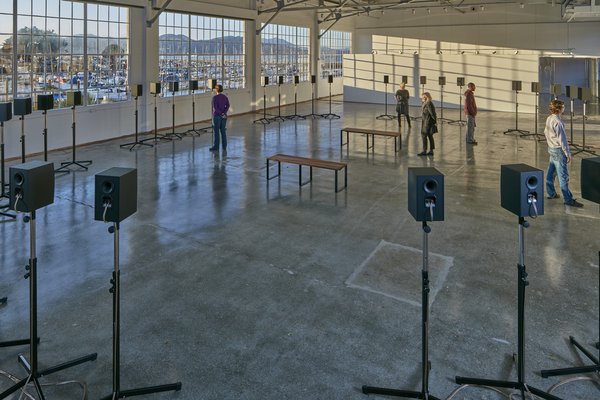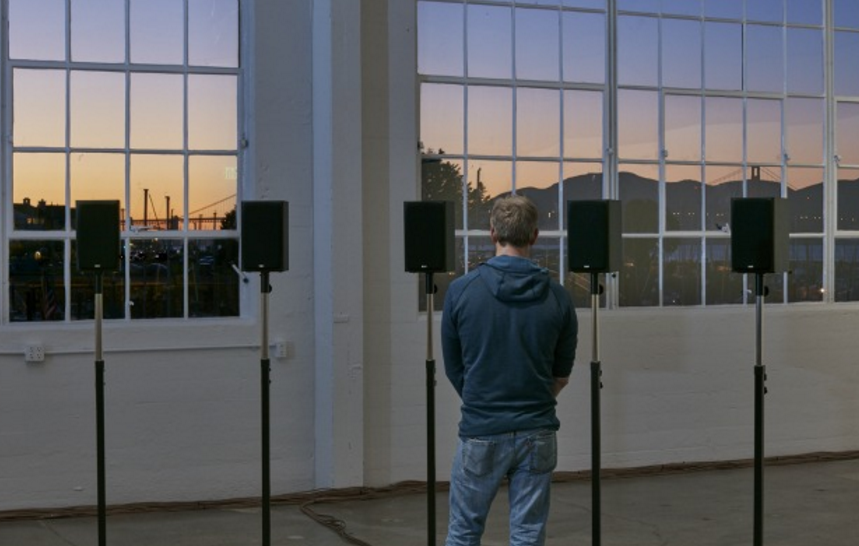 At an Artist Talk on November 14, Janet Cardiff and her partner, George Miller, spoke about their ongoing interest in projects that merge live and recorded moments, and how these two worlds merge to create a third realm. In Cardiff’s The Forty Part Motet, the acoustic landscape carries a tangible effect, like a blanket that wraps around a listener, and shifts according to where a person stands and moves.
At an Artist Talk on November 14, Janet Cardiff and her partner, George Miller, spoke about their ongoing interest in projects that merge live and recorded moments, and how these two worlds merge to create a third realm. In Cardiff’s The Forty Part Motet, the acoustic landscape carries a tangible effect, like a blanket that wraps around a listener, and shifts according to where a person stands and moves.
Cardiff created this work in 2001 and it has since toured nationally and internationally. Last month The Forty Part Motet made its California debut when SFMOMA and Fort Mason Center for Arts & Culture collaborated to bring the piece to San Francisco’s Gallery 308.
Rudolf Frieling, curator of media arts at SFMOMA, uses the word “intimate” when he describes the experience: “Cardiff’s address of the audience as a single person, free to move on stage, is part of what makes her work so emotionally intense. She creates a one-to-one relationship between the listener and a human voice that’s very intimate, even in a public setting.”
The word “immersive” is frequently used to describe a genre of performance that invites audiences to wander through an environment or setting––as in Punchdrunk’s Sleep No More––and to interact with performers in direct and sometimes intimate ways––as in Joe Goode’s Poetics of Space. Usually immersive events are multilayered, lasting for an hour or more, and involving specialized casts and technical crews.
This is what makes Cardiff’s The Forty Part Motet distinct among immersive creations: her installation consists of 40 speakers arranged in an oval, and the recording that is played through these speakers dates to 1573, Spem in alium nunquam habui (I have never put my hope in any other), by English composer Thomas Tallis. The installation’s 14-minute audio loop includes 11 minutes of singing and three minutes of intermission.
When I visited the installation last week I felt immersed in the sounds that are created, surrounded by waves of voices. The speakers produce such distinct and vibrant recordings that when I closed my eyes it seemed like I was in Salisbury Cathedral where the recording was made. Opening my eyes, and watching the boats bob on the water of the marina, it seemed like I was within a glorious soundtrack for a maritime film. As visitors entered the gallery, some would walk very close to one speaker, as if drawn by a magnet to a certain voice. Reviews of Cardiff’s installation include far more glowing descriptions.
Another through-line of Cardiff’s work is her interest in how people attribute cause and effect to situations that are not connected. In The Forty Part Motet, although there are 40 speakers in the room, there are 59 singers, adults and children, who perform the music. Moving through the installation is an enlivening experience, one that negotiates between presence and absence, between what is seen and what is imagined, and that triggers a heightening of the senses.
The installation will be on view until January 18, 2016 and admission is free but reservations are recommended. For more information, see here.
By Kate Mattingly
This review was written for the Art + Design Initiative’s visit to The Forty Part Motet in partnership with the Berkeley Center for New Media, the Arts Research Center, and the UC Berkeley Center for Interdisciplinary Research. Special thanks to Susan Miller for coordinating this special opportunity for the UC Berkeley campus.
